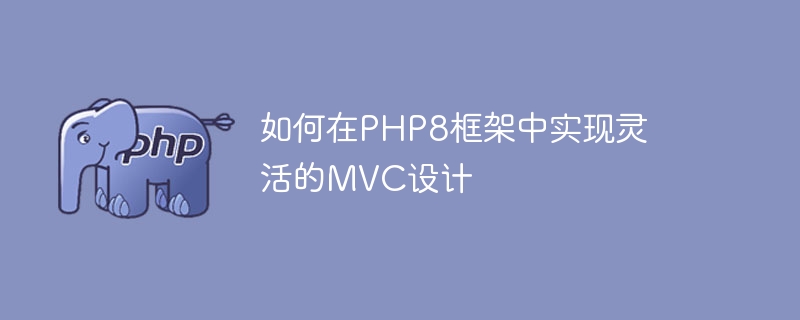
How to implement flexible MVC design in the PHP8 framework
Abstract: MVC (Model-View-Controller) is a commonly used software architecture pattern used in Implement separation of logic and views in web application development. This article will introduce how to implement flexible MVC design in the PHP8 framework to help developers better organize and manage code.
1. Introduction to MVC design pattern
MVC design pattern is a software architecture pattern that divides an application into three core components. These three components are Model, View and Controller. The model is responsible for handling the data logic of the application, the view is responsible for presenting data to the user, and the controller is responsible for processing user input and updating the model and view.
The advantages of the MVC design pattern include:
- High code readability and maintainability because the responsibilities of each component are clear and clear;
- Modular development , different components can be developed and tested independently;
- Improve the reusability and scalability of the code and facilitate subsequent function iteration and maintenance.
2. MVC implementation in the PHP8 framework
Implementing the MVC design pattern in the PHP8 framework can provide better code organization and management. Here are some steps and techniques for implementing MVC:
- Separating models, views and controllers
First, the code needs to be separated according to the principles of the MVC design pattern. Put data manipulation and processing logic on the model layer, page rendering and user interaction logic on the view layer, and user input processing logic on the controller layer.
- Routing and URL design
In the PHP8 framework, routers can be used to manage the distribution of URLs and requests. The request can be distributed to the corresponding controller and method according to the rules of the URL. For example, you could dispatch "/user/show/1" to the UserController's show method, passing parameter 1 as the user ID.
- View template
In the view layer, you can use a template engine to render the page. The template engine can separate data and page structure and provide a more flexible page rendering method. In the PHP8 framework, commonly used template engines include Twig and Smarty.
- Interaction between controller and model
The controller is responsible for receiving user input and calling the model's methods to process data logic. The model is responsible for processing the addition, deletion, modification and query operations of data. In the PHP8 framework, you can use ORM (Object Relational Mapping) to simplify database operations, such as using Eloquent ORM or Doctrine ORM.
- Dependency injection and service container
The PHP8 framework provides dependency injection and service container functions, which can help us better organize and manage application dependencies. Components such as models, views, and controllers can be injected into applications through dependency injection, making the code more flexible, testable, and maintainable.
- Middleware and filters
Middleware and filters are commonly used functions in the PHP8 framework and can be customized during the request and response process. Operations such as authentication, logging, and data filtering can be added to middleware to control and manage requests and responses.
3. Summary
Implementing flexible MVC design in the PHP8 framework can improve the readability, maintainability and scalability of the code. By separating models, views and controllers, rationally designing URL routing and using the view template engine, and managing component dependencies through dependency injection and service containers, the concept of the MVC design pattern can be better realized. At the same time, combining functions such as middleware and filters can increase the flexibility and scalability of applications. I hope this article has provided some inspiration and help for implementing flexible MVC design in the PHP8 framework, allowing developers to better organize and manage their own code.
The above is the detailed content of How to implement flexible MVC design in PHP8 framework. For more information, please follow other related articles on the PHP Chinese website!

